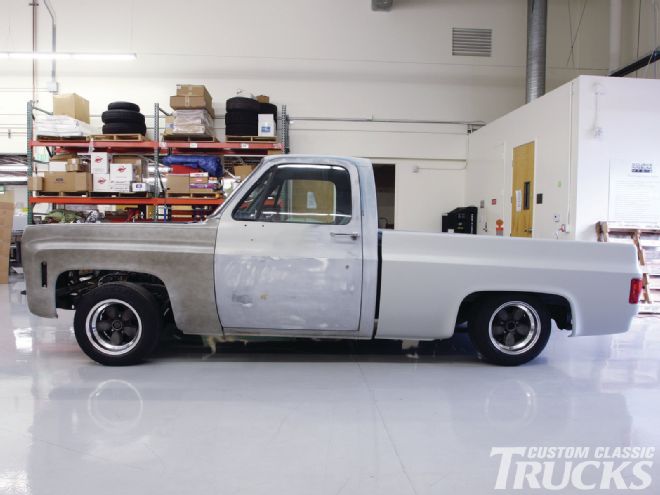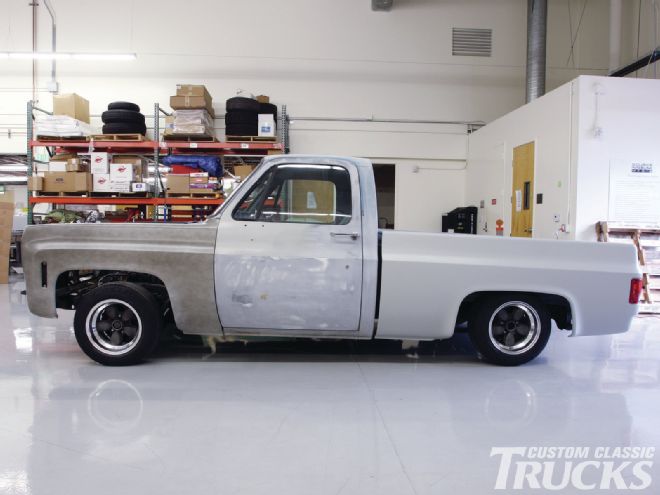
Lowering a later-model truck that’s already equipped with independent front suspension should be a fairly straightforward application, right? Just slap on a pair of lowered coils or a set of dropped spindles and you’re ready to rock, right? Well, not exactly. You see, back when GM was designing the third generation of their C10 line, they didn’t take into consideration the fact that thirty-plus years later, guys would be doing the things that they are now doing. They built the trucks strong and rigid without as much thought about things such as aesthetics or performance. Back then, pickup trucks had more in common with a flatbed hauling produce to the market than it did with a passenger car, although that was quickly changing.
 Here’s how the stance currently looks on the Chevy; not too appealing. Josh managed to coerce the rear end down nice and low, on the bumpstops mind you, but the front was still sitting high and dry.
Here’s how the stance currently looks on the Chevy; not too appealing. Josh managed to coerce the rear end down nice and low, on the bumpstops mind you, but the front was still sitting high and dry.
But thirty years on, guys are demanding things from these trucks that the original engineers had never intended. Big brakes, bigger wheels, and more powerful engines require the stock components to work outside their established parameters. And when you start altering the suspension characteristics, other problems soon arise.
One of the biggest hurdles in lowering a third gen Chevy C10 is the massive front crossmember. It hangs low, it’s bulky, and it’s ugly. Short story shorter, it’s in the way. So why not get rid of it? Well, that might be a lot of work, except for one thing: the entire front suspension clip bolts to the chassis! Less than twenty bolts need to be removed before the entire kit and caboodle can be lambasted to the back forty. But what to replace it with? Enter Fat Man Fabrications.
Fat Man’s head engineer Brent VanDervort was familiar with the problem the third gen’s faced and decided to tackle it using one of his popular Mustang II-based IFS kits. Designing a bolt-in crossmember similar to Fat Man’s other weld-in units, Brent solved half a dozen problems at once. Not only was the new crossmember more attractive, it also tucked up nearly six inches tighter to the chassis, gaining that much in ground clearance while lowering the truck four inches. It also allowed their stainless steel tubular control arms to bolt right up; a stiffer, stronger, and far and away better looking alternative to the stock Chevy stamped steel counterparts. This also opened up the door to allow each kit to be customized to accept a variety of suspension designs, from coil springs to coilover shocks to air-ride systems. The addition of a rack-and-pinion attachment at the front of the crossmember meant converting to a power steering rack was a simple bolt-on task, along with the more precise control gained by using a rack over a traditional steering box. And since Fat Man’s spindles accept a myriad of disc brake kits, upgrading to big brakes was a snap. Meanwhile, Brent knew that the truck guys were starting to lean toward bigger tire and wheel combos but were running into fitment problems due to the larger tires not tucking up under the fenders. His solution was to narrow the track width of his bolt-in kit to better fit a bigger roller.
The answer to the problem that’s plagued Chevy lovers since the first Gen III truck was lowered was so simple in hindsight that it’s almost bizarre as to why GM did what they did. That massive crossmember can be replaced with a much simpler, more refined unit and the framerails boxed to make a much cleaner unit, all the while gaining the aforementioned upgrades. It sounds almost too easy doesn’t it? Well it really was. We pulled out the stock suspension and had the truck back on the ground with all the new components in a day. Depending on how determined you are, I’d bet to say you could pull your truck in on a Friday night and drive it to work Monday morning, all bolted back up and ready to rock; albeit four inches lower! CCT